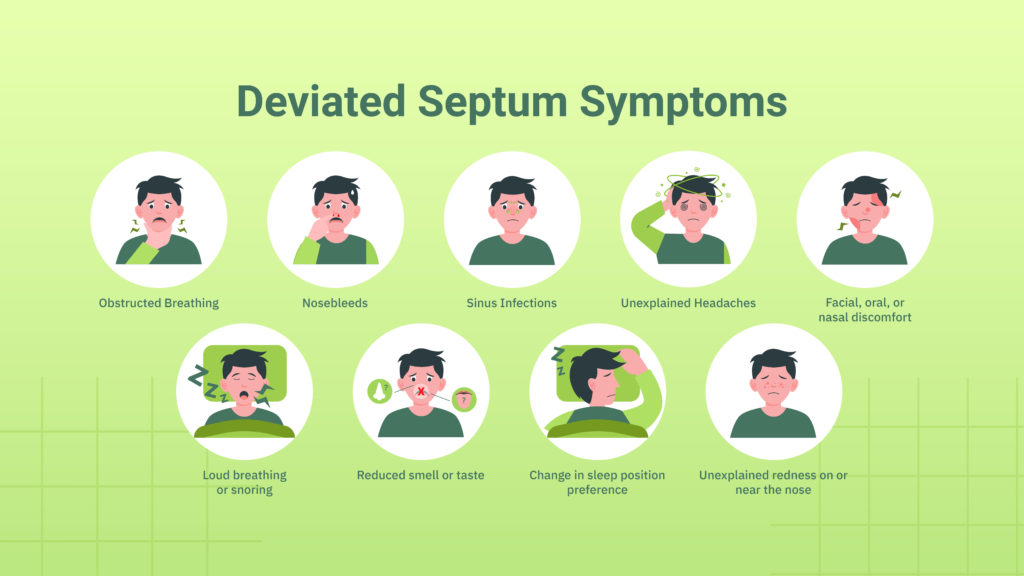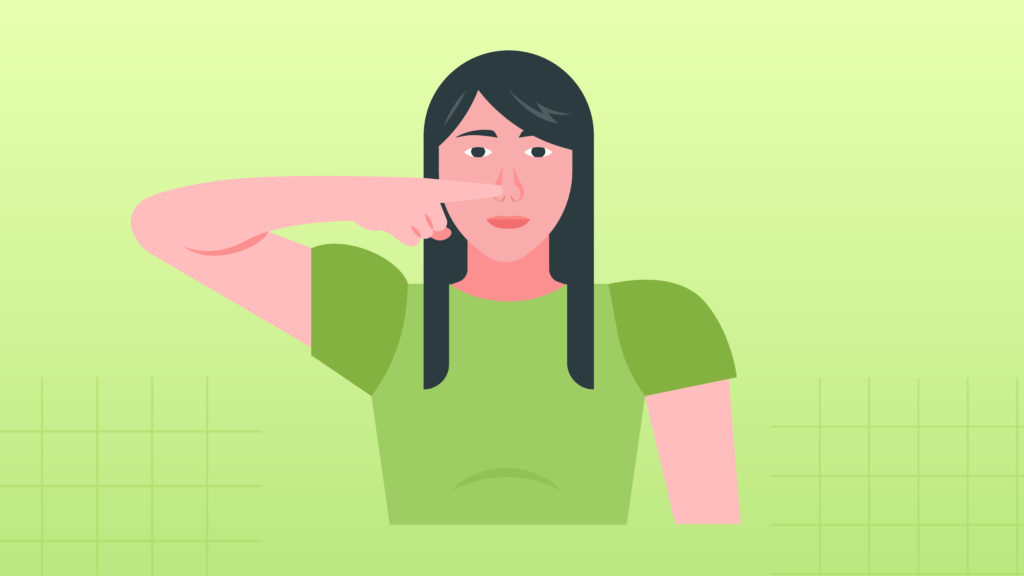In many cases, obstructive sleep apnea is caused by muscle tone (or a lack thereof) where the nasal passages and throat connect.
However, if you’re having trouble breathing or sleeping but don’t believe this to be the cause, there could be another issue at fault: a deviated septum.
Fortunately, if you’re curious if this might be an issue for you, two simple self-test options are available.
In this article, we’ll discuss what it means to have a deviated septum, how deviated septums occur, common symptoms of a deviated septum, how to perform a self-test at home for the condition, and treatment options available once diagnosed.
By the time you’re done reading, you’ll be able to confidently approach your general practitioner and take the next steps in diagnosing and resolving your issue!
What is a Deviated Septum?
Your septum is the thin wall of tissue that separates your nostrils. If you reach up and touch the part between your nostrils, you’re touching and moving your septum.
Typically, this tissue runs nice and straight, providing equal airflow and smooth breathing from either or both nostrils.

However, sometimes, the septum becomes curved, wavy, or otherwise deformed.
This condition is broadly known as a deviated septum.
The condition is often somewhat unique per occurrence in terms of shape, and severity can vary due to the cause of the deviation, nasal structure, and other factors.
What Causes a Deviated Septum?
Injury- or accident-related trauma is the most common cause of a deviated septum. This is especially prevalent in sports-related injuries or injuries resulting from automotive accidents.
However, genetics and congenital disabilities can also lead to a deviated septum.
In most cases, this is detected and addressed at a young age or the result of an event later in life.
However, in some cases, structural weakness can also result as a part of aging.
What are the Symptoms of a Deviated Septum?
Obstructed breathing from one side of your nose is the most common symptom of a deviated septum.
This is because the abnormal path of the septum will displace tissue and deform the nasal passage on one side while typically opening another.

According to Mayo Clinic, this inflammation and nasal obstruction can also result in other symptoms. Additional symptoms include but are not limited to
- Nosebleeds: Often, deformation of the nasal septum will lead to dryness and irritation, increasing the chance of nosebleeds.
- Frequent sinus infections: These same deformations can make it difficult for the natural cleansing processes of your nose to eliminate bacteria and other irritants, which could lead to increased sinus infections.
- Unexplained headaches: Shifting pressure or nasal congestion can often lead to chronic headaches or migraines, which come and go rapidly as pressures change.
- Facial, oral, and nasal discomfort: In severe cases, a deviated septum can create pressure in the nasal cavity, increasing facial and oral pain and sensitivity.
- Loud breathing or snoring during sleep: The abnormal shape of the nasal passages and inflammation caused by a deviated septum can lead to noisy breathing during sleep.
- Reduced sense of smell or dulled taste: In cases with severe obstruction, reduced airflow can impact both taste and smell.
- Preference for sleeping on a particular side: Many people with a deviated septum will find breathing easier when they lay on the side that takes the pressure off their obstructed nasal passage.
- Unexplained redness on or near the nose: In some cases, swelling and tissue displacement can lead to skin irritation or additional pressure. This often manifests as redness.
As you can see, a septal deviation can noticeably impact quality of life.
While it might sound like a minor concern at first glance, it can create lasting symptoms that impact routines and comfort around the clock.
How Can You Self-Test for a Deviated Septum?
While an official diagnosis will require inspection by a medical professional (more on that later), there are two methods you can use to establish the probability of a deviated nasal septum.
With this information, you can follow up with your general practitioner or an ear, nose, and throat (ENT) specialist to confirm your case and determine the best course of treatment for your condition.
Let’s look at the two deviated septum self-test options available!
Self-Test #1: Obstruction Comparison

Don’t let the name fool you.
This test is simple and will only take a few seconds.
Better still, you don’t need any equipment or setup. You can probably do it where you are right now.
- Start by covering one nostril with your fingertip or compressing it closed.
- Breathe normally, paying attention to both your inhalation and exhalation.
- After taking note of any difficulty breathing, switch sides of your nose and block the other nostril.
- Repeat your breathing in a steady, consistent pattern.
- Now, compare your results.
If you’re otherwise healthy, not experiencing any seasonal allergies, and still notice that one side of your nose offers better airflow than the other, this could indicate a deviated septum.
Self-Test #2: Visual Inspection

This deviated septum self test is a little more involved.
You’ll need a light source (the light on your phone will likely work), a mirror, and somewhere to sit.
- Sit down facing the mirror.
- Push up gently against the tip of your nose.
- Shine the light into your nasal passages.
- Look at the position of the septum (the line of skin between your nostrils and nasal passages.)
If you notice any misalignment or deviation, you should follow up with your doctor or an ENT specialist for further confirmation of the condition.
Both tests take just a few minutes and can be an excellent way to start a conversation with a medical professional about your suspicions.
Official Diagnosis Process for a Deviated Septum
While you can’t diagnose a deviated septum at home, you shouldn’t worry about the diagnosis process either. It’s generally non-invasive and pain-free.
Typically, your physician or ENT specialist will conduct a more in-depth version of the visual inspection, sometimes using sterile swabs or decongestant sprays to provide easier access to deeper regions of your nasal passages.

In obvious cases, this will be enough for a doctor to make a confident diagnosis.
However, an MRI is often used in cases where the deviation is not near the front of the nose or where the doctor wants to know how to best proceed with treatment.
This provides a clear image of both nasal passages and can rule out other causes.
The image can also serve as the foundation for determining effective treatment.
Deviated Septum Treatment Options
Popular treatments fall into two categories:
- Non-surgical treatments
- Surgical treatments
Let’s explore both sets of options.
Non-Surgical Treatments for a Deviated Septum
In cases with only slight deviations or when surgical options are not feasible, treatment with nasal sprays and decongestants can help to alleviate congestion and help to maintain adequate airflow despite the altered path of your nasal passages.
Sometimes this is paired with nasal irrigation to remove mucus buildup and to help hydrate and soothe irritated skin near the deviation sites.

Mild cases can also benefit from PAP therapy to help keep airways clear and open.
In some cases, steroid injections can reduce swelling for extended periods but will often require regular injections to maintain the result.
Surgical Treatments for a Deviated Septum
If the obstruction is severe or non-surgical options don’t provide a sustainable or meaningful improvement in your symptoms, specialists will typically suggest one of three surgeries:
- Septoplasty: reshaping or removing parts of the septal cartilage that makes up the wall between your nasal passages and restoring a straight pathway.
- Turbinectomy: removing one or more of the turbinates in your nose. These small bony structures typically help to clean and humidify air as it travels through your nasal passages. This is often performed along with septoplasty.
- Rhinoplasty: more casually known as a nose job, rhinoplasty reshapes your nose’s outer structure in more significant ways than septoplasty might.
Whether opting for surgical or non-surgical options, your physician or ENT specialist can help guide you through each option’s pros and cons, provide you with clear timetables on what to expect from recovery, and follow up to ensure that the treatment is working as intended.
Key Takeaways
- Your septum is the tissue and cartilage that separates your nasal passages.
- Normally, this runs in a straight line. If the path becomes distorted, this is known as a deviated septum.
- Typical causes of a deviated septum include injury- or accident-related trauma, genetics, and congenital disabilities.
- Symptoms of a deviated septum include obstructed breathing, nosebleeds, frequent sinus infections, unexplained chronic headaches, facial discomfort, loud breathing or snoring while sleeping, reduced sense of smell, dulled sense of taste, and unexplained redness on or near the nose.
- Two at-home tests can help you start the detection process. One is visual, while the other monitors airflow. Both are simple to perform.
- Professional diagnosis is required for treatment.
- Diagnosis typically involves a visual inspection or MRI.
- Non-surgical deviated septum treatments include PAP therapy, nasal decongestants, nasal rinses, and steroid injections.
- Surgical deviated septum treatments include septoplasty, turbinectomy, and rhinoplasty.
If you or someone you know are living with a deviated septum, PAP therapy can offer relief and help you to sleep and breathe better. To determine if a deviated septum may be causing your sleep issues, use the quick self-tests above to assess whether this could be an underlying factor. With CPAP Supply’s help, we can find the right solution for getting a good night’s rest and restoring your quality of life!

